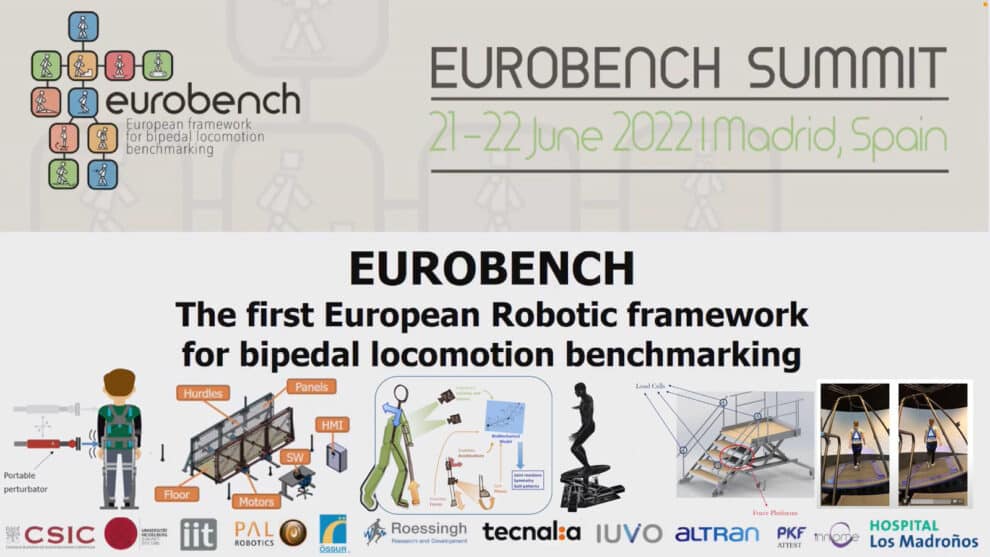The EU-funded EUROBENCH project concluded with a two-day EUROBENCH Summit. EUROBENCH is the first European Robotics framework for bipedal locomotion benchmarking. Out of those, almost three-quarters (71%) were exoskeleton devices. The talks of this final event, held June 21-22, 2022 in Madrid, Spain, were recorded and can be accessed for free on YouTube:
- EUROBENCH Summit Tuesday 21, June 2022: Link to YouTube
- EUROBENCH Summit Tuesday 22, June 2022: Link to YouTube
The EUROBENCH Summit recordings are about 14 hours in length. The summit aimed to bring 17 presentations, most of which were on exoskeletons and wearable robotics. Topics included: balance while using exoskeletons, moving through narrow spaces, measuring upper limb involvement, benchmarking exoskeleton-assisted gait, navigating stairs, and inclusion of the devices and prior standards. Additional sessions included human-robot interactions and performance.
Goal:
In his opening presentation, Diego Torricelli, defined the goals of EUROBENCH as creating a unified methodological and experimental ecosystem that leads to reproducible and measurable evaluations. These evaluations would lead to the ability to create accurate and reliable comparisons between exoskeletons and bipedal robotics. Put differently by the presenter, move away from “demos that don’t demonstrate anything.” There are many ongoing pilots of wearable robotics technology taking place worldwide, but unfortunately, almost all of them use unique data collection methodologies. This makes aggregating the data between studies impossible. EUROBENCH aimed to disrupt this by creating benchmark methods, two testing facilities, and a cloud-based data center where all experimental results can be loaded and analyzed.
In chronological order, the summit included presentations on:
- The funding pathways for future work. The EUROBENCH team will continue to apply for grants through Horizon Europe, but there are other options available to them as well.
- A test bench on balance recovery with a lower-body exoskeleton using a handheld perturbator.
- A reconfigurable walkway to test for exoskeletons in a narrow passageway.
- A measurement system to record the impact of crutches used for balance and turning with some gait-assist exoskeletons.
- Analysis of user-centric design.
- A tilting platform to assess user balance with a lower-body exoskeleton.
- An adjustable staircase to measure navigating stairways while wearing an exoskeleton.
- Benchmarking of gait stability on a tilting treadmill.
- Sit to stand evaluation.
- An evaluation of diversity considerations in published exoskeleton standards.
- An example of the evaluation of an exoskeleton using the adjustable staircase and embedded and external sensors.
Memorable Takeaways
- Demos that demonstrate nothing. Marketing material with an unknown number of takes to achieve the desired media material is not useful for creating and growing an exoskeleton technology marketplace.
- Safety testing is far more important for commercialization than performance testing. Researchers love performance testing, but safety is what certification and the industry requires. (This sentiment aligns with the ET CoE survey on Industrial Exoskeletons).
- Safety is the bridge between the research and commercialization (developers) community.
- Accelerating exoskeleton adoption can be solved at the community level (said Nicola Vitiello, co-founder of IUVO):
- Lack of clear evidence of effectiveness in the final workplace.
- Lack of clear information to communicate with all the stakeholders.
- Education, not price, is holding back this industry.
About EUROBENCH:
Thanks to the collaboration of the funded entities, EUROBENCH has developed:
- Two Testing Facilities, one for wearable robots (located in the Hospital Los Madroños, in Brunete, Spain) and the other for humanoid robots (located in the Istituto Italiano di Tecnologia, in Genova, Italy), to allow perform standardized tests on robotic prototypes in a unique location, saving resources and time.
- A unified Benchmarking Software, which includes: a) common protocols to execute standardized tests in any lab setting, b) computational tools to compute performance scores according to quantitative Performance Indicators, and c) a unified database to compare the performance results with other systems.
This final event aimed to bring together all the entities that have participated in the development of EUROBENCH.
References:
- EUROBENCH website: link
- EUROBENCH Summit website link
- EUROBENCH Summit Tuesday 21, June 2022: Link to YouTube
- EUROBENCH Summit Tuesday 22, June 2022: Link to YouTube








Add Comment